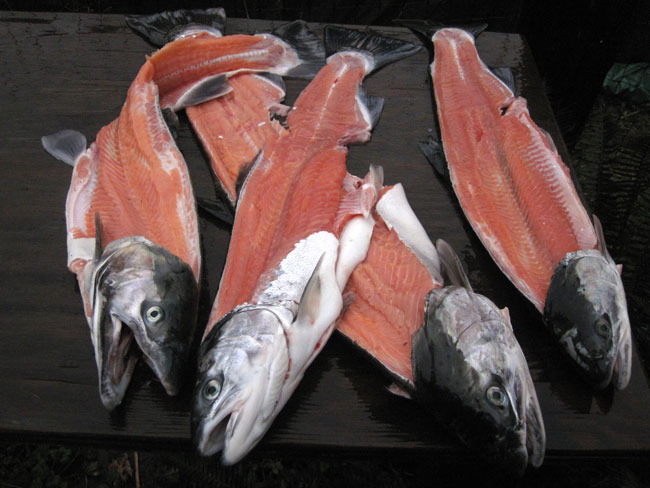
With the Japanese house mostly complete, I found myself looking for a way to celebrate the festive season. My focus seized upon perhaps the most innapropriate of targets for those looking to actually enjoys the holidays, the winter steelhead. To this date I'd caught precisely one steelhead in three years of trying, my season being a predictable arc of hope, frustration, and ultimately dissilusionment. Why I would choose this as a 'reward' must speak to some personality defect that I'd rather not reflect upon for too long. Essentially a giant mutant sea running trout, steelhead look like salmon and grow big like salmon, but unlike salmon, they refuse to die after spawning. Also unlike Salmon, they are rarely sedentary, preferring faster water to oxygenate a much hotter metabolism. All this translates into a fish with serious attitude when connected to the end of a line. Did I mention that Steelhead are also the most delicious of all the salmonid species? well now I have.
Now for the bad news. With native populations pretty decimated, anglers these days rely on hatchery releases to satisfy their hopes of hooking one of these beautiful fishes, and even with those releases, there just aren't many of them out there outside of a few peak weeks. For the few that are swimming around, they find ample cover from winter months they inhabit. The water is more often than not too high, too low, to murky, too clear, or worst of all, too cold. In fact one might say that steelhead fishing is synonymous with cold.
Before we embark on this frozen tale, I should start by disclosing that I was born with is genetic lack of patience and discipline. All my life I've compensated for this by simply avoiding tasks that require these virtues. It's why I make my living teaching people to build kayaks, in a week. It's why I've owed the IRS ninteen dollars and seventy-five cents for over a year. It's why I should never, ever go steelhead fishing. I am also, paradoxically, possesed of a ferocious motivation level, so much so that I can't back down from anything I've set my mind to. Combine both of these attributes with a highly elusive fish and some seriously abject conditions, and you have a perfect recipe for an emotional meltdown, but let's not talk about that just yet.
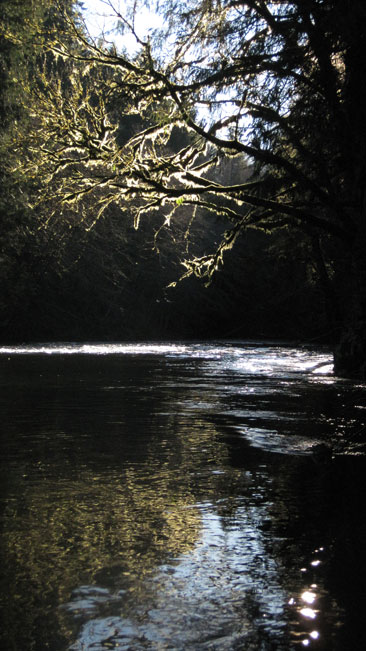
I'm incredibly fortunate to live on the banks of the North Fork of the Nehalem river. This beautiful coastal tributary winds down through fern and moss-draped gorges with numerous enchanting waterfalls, and some excellent intermediate-level whitewater kayaking. On it's journey the river passes the Nehalem Fish Hatchery, which releases thousands of Steelhead smolts every year to give persistant anglers a chance at a steelhead dinner. Wild fish in these parts are strictly catch-and-release. I run the North Fork nearly every day it has enough water to float a kayak. With a fun class 3-4 section up top and a gorgeous class 2-3 section in the bottom it provides a rare opportunity to keep my whitewater skills sharp without all the driving that is endemic to the sport. This year I noticed quite a few fishermen lining the banks in early December, and at one point I even quipped to a buddy "These guys ain't catching shit, it's too early." It turns out that while I was still in whitewater mode, the steelhead had in fact arrived early and gleeful locals and guides were slaugtering them left and right, a tale I caught wind of only after the excitement had abated. Like most fish stories though, it planted a seed that grew in a few short days into an insatiable desire to hook a winter steelhead.
I borrowed a friends steelhead rod and began fishing in earnest, which means waking at dark, donning 3 layers of fleece, a drysuit and kayaking gear, and driving to the fish hatchery to launch my kayak at the butt-crack of dawn. For these sorts of missions I'll often bring a creek boat simply because it's easy to get in and out of frequently, but the ideal tool for kayak steelhead fishing is my Aire Lynx, 10 ft inflatable kayak. From it I not only fish better, but it makes an ideal platform for reaching up to snatch tackle that other fishermen have lost in the numerous overhanging branches, and over the course of my first couple runs, I managed to collect a substantial arsenal of nearly new spinners, slinkys, jigs, and bobbers. Paddling down from the fish hatchery I generally leave the first few pools to bank anglers who have few other opportunities. It's not uncommon to have a few rafts, some private, some professional guides, taking to the water at about the same ungodly hour which can create some pretty irritating congestion in the first couple of miles.
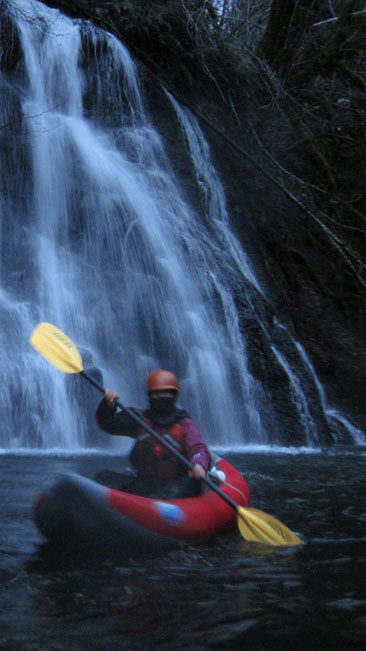
Leann, the river ninja returns
I fished the next couple days hard, but I can't say I fished them well. In theory steelhead fishing should be easy. My neighbor, who catches quite a few fish, put it this way: "You just keep throwing it out there and eventually you get one." I was doing exactly that and after two ten hour days, I hadn't gotten one. I was easily frustrated, and it was causing me to overfish some areas, miss others entirely, and spend way too much precious daylight dicking around with my pole and tackle (that doesn't sound good). Anyways, I responded to my lack of fish with the persistant application of more poor fishing, which unsurprisingly, yielded similar results. I even managed to lure my girlfriend down the river on several of these excursions, where my increasingly unsportsmanlike attitude ruined what should have been an enjoyable holiday activity. Nevertheless the river was as beautiful as ever and we had some pretty magical moments on the water.


For two days a rainstorm saved me from myself and while the river flooded Leann and I made wooden Japanese lamps for the house, which was also a bit frustrating due to the diminutive mortise-and-tenon joinery that had me feeling like I was trying to build a ship in a bottle. We got them done though (complete with handmade paper!) and were quite proud, and soon enough the water was dropping and it was time to try our luck again. We made a quick afternoon run at the still high flow, and had a ton of fun blasting through the rapids, and stopping to fish occasionally. It was the best day I'd had on the river yet!
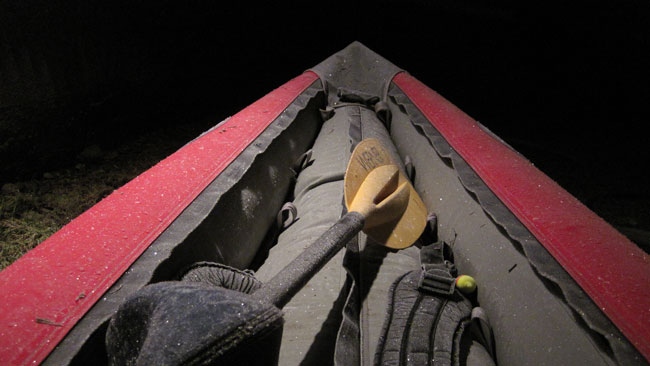
A high water event always triggers a pulse of new fish into the river, and the fish were certainly fighting to break down the gates at the hatchery, somewhat poigniantly trying to reach a spawning bed that doesn't actually exist. This recent flood of murky water also triggered the largest pulse of fishermen I have ever seen on the North Fork. The parking lot at the hatchery was completely full and the banks were lined with fishermen even before daybreak. It was also extremely, f-ing, cold. With the air temp at twenty degrees and the water at thirty-five, steam poured eerily off the river as I charged downstream to beat the crowds and get set up on a good spot. Passing by a lot of decent water I positioned myself on a promising corner, and after several casts I saw a fish flash and the bobber submerge, but when I yanked back there was no fish on the other end. Then a raft came drifting over my spot. I told myself to be patient, and took some time to sort out my gear and after fifteen minutes started fishing again, and another raft drifted over, and another, and another. After several hours of leapfrogging rafts and contending with a dearth of bank fishermen like I'd never seen before, I had once again become sour and unpleasant despite all the promises I'd made myself about staying relaxed. I also had frostbite, and I'm not meaning that in a "gee shucks it sure was cold" sort of way, no, I literally had frostbite on the tips of two of my toes. I also had no steelhead, while the fishing guides in front of me had collected seven.
I fished the next day without the crowds, yet still without catching anything. I was still fishing poorly. Unlike salmon or rockfish or halibut or virtually any other fishery where sheer persistance will eventually yield some results, for all but the very lucky winter steelheading requires at least some level of expertise. There are several strategies that work well for steelhead, spinners, jigs, drift, and flys, and all will work well in the hands of someone who knows what they are doing, which obviously wasn't me. Granted luck should have given me one fish at least by now, I began to get a sinking feeling that I wasn't going to get off easy. If I wanted to catch a steelhead I was actually going to have to learn how to fish.
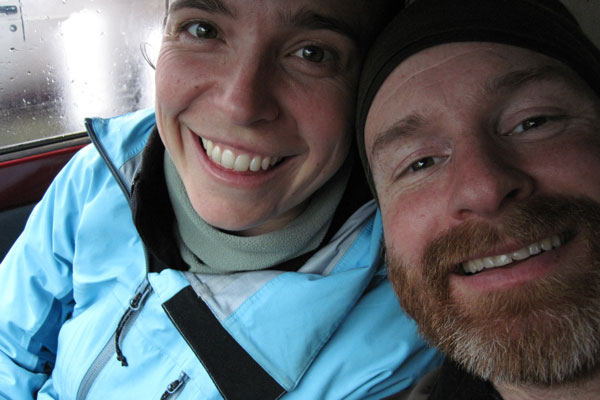
To save my relationship from SSS (steelhead stress syndrome) I took a day off and spent it with Leann, a wise choice that restored domestic harmony. Then the next day I invited my buddy Mark down and we hit it again, early morning, working downriver, pool to pool, seam to seam, tailout to tailout. Steelhead are very sluggish and reluctant when it's very cold, and it was still very cold. Near the end of the run, Mark switched to spinners and picked up a nice hatchery fish in fast water at the head of a pool. This was Mark's first winter steelhead despite several years of trying and it was very exciting for both of us. For the next hour we worked that pool to death in hopes of a second fish which did not materialize. I realized that I like spinner fishing. I've always liked spinner fishing. The steady thrum of the blade feeds me information about depth and speed, it makes me feel connected to the water. Jig and bobber is undoubtedly the more productive setup for this river, but I just don't enjoy fishing that way, so I contemplated a switch to the ample supply of spinners I'd pulled out of the trees over the last week.
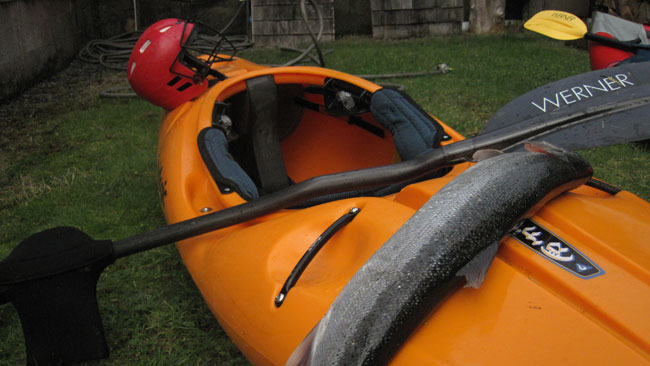
Mark's steelhead
I spent untold hours that evening (and every evening) scouring the internet for information about steelhead fishing and the next morning I took to the task with renewed vigor. I was obsessed. At this point steelheading had become akin to a bad gambling debt, I'd put so much time in and invested so much that walking away was no longer an option, so I pulled on my drysuit in the dark and headed back to the casino. This was an especially bad day. I chose to experiment with an anchoring system for the kayak that would allow me to mimic the movements of the raft guides. Not only did it scare the fish, but it also resulted in several mid-rapid anchoring disasters that had me chasing gear all over the river and feeling (and looking) like a complete ass. I spoiled pools that might have held fish, and I was still switching gear too often, which cost me time, and time is the shortest commodity in a river where there might only be three or four aggresive fish on any given day. For a final humiliation I did finally catch one six-inch long trout fifteen minutes after the sun went down.
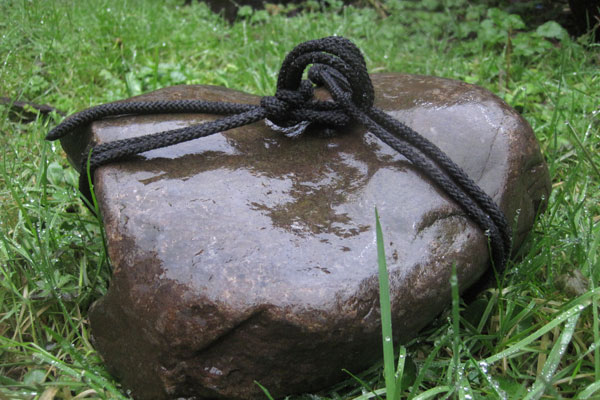
the anchor
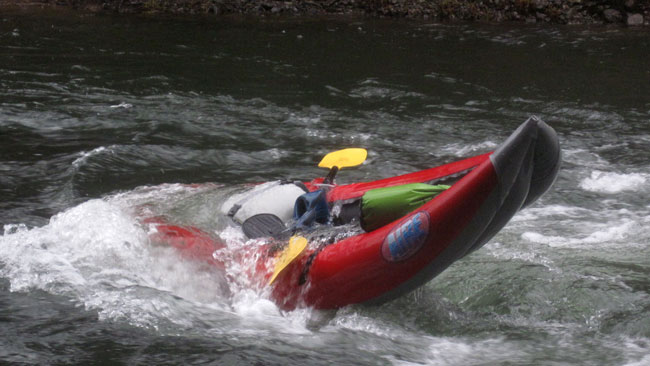
the anchor catastrophe, it took me two hours and some highly unpleasant freediving to free the boat. I refused to cut the line becuase I didn't want it down there snagging every lure that passed through.

a similar fish I hooked the next day
I walked into the house as low as I've been in a long time, and entirely aware that it is not normal to get so upset about fishing. It wasn't just about fishing anymore though, the quest for steelhead had come to symbolize an entire litany of my personal shortcomings, and I simply couldn't do the right thing, the sane thing, and quit. The steelhead was my white whale. I fired up the Mac and proceeded to read compulsively about steelhead on the internet. I was now an expert at fishing for steelhead on google. There is some good info online though, and combined with seven days of learning the river with a degree of precision I'd never before imagined, along with watching raft guides, certain ideas were beginning to finally percolate into my thick skull:
1) Steelhead become very sluggish in cold water
2) Casting at the same spot over and over is a waste of time.
3) Any water 2 1/2 -8 feet deep and moving can hold a steelhead.
4) You will not fish well if you don't enjoy the system you are using.
These things had become obvious to me many days earlier, but like so many things in life, seeing what needs to be done is the easy part, it's actually doing it that's hard. I was still fishing erratically, missing spots that might hold fish, lingering at places I liked and wasting time there, covering pools in a spotty way, and still dicking around with gear. That evening I came to realize that what really bothered me wasn't not catching a fish, it was that I wasn't fishing well. I decided that if I could cover the river, carefully, methodically, completely, just once, then I could let it go and move on.

The next morning I arrived at the hatchery put-in with minimal gear, and a very different attitude. The water was still low and clear but finally it wasn't so bitch-ass cold outside, which could only help things. I chatted with a friendly fly fishermen in a raft and then headed downriver, stopping at each possible holding spot and fishing it from one end to the other, casting and retrieveing as I walked. Then I got back in the boat, and moved to the next spot. It was incredibly hard. The mind, especially my mind, is deviously distractible. I wanted to cast back at places I'd just covered, I wanted to switch to a different spinner, I wanted to take photos of the river. There were just so many things I wanted to do other than what I needed to do, which was: fish carefully and keep moving. I forced myself to do it, cast, step, cast, step, cast, step, get into boat, and move to the next spot, cast, step...
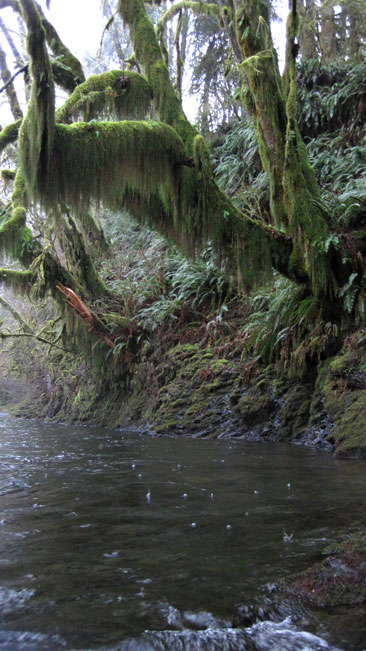
there is no way I'm going to put a photo on the internet of where I hooked a steelhead, just so you know
I hooked my first fish exactly where I'd seen my bobber go down a few days earlier. It was a bit sluggish, tugging hard as I worked it carefully to shore, but with none of the acrobatic leaping or reel melting antics I'd read about. I kept a constant tension as I worked him not-too-hard for about 3 minutes until suddenly with a powerful shake he threw the hook and my pole went slack. The steelhead may not have gone berserk, but I did, splashing in a wild fit of rod shaking and yelling the f-word over and over. The same friendly fly-fishermen I'd met earlier looked on with amusement, and then shouted encouragingly "there's another one in there, I guarantee it!" In the next few minutes I'm certain that I used up my lifetime supply of self control as I forced myself to keep working the pool, calmly, methodically. Step, cast. I worked downstream to the end of the run and when I walked back up I found that fly fishermen engaged in an epic battle with the other fish he'd warned me about. This one was native, and large, and it led him on a wild chase from one bank to the other where he demonstrated not only impressive wading skill but a close knowledge of the river as he ventured wherever the fish pulled. As tempting as it was to stay and watch this fight play out, I reminded myself that I wasn't fishing, and waded back to my kayak and paddled downstream. Step, cast, step, cast.
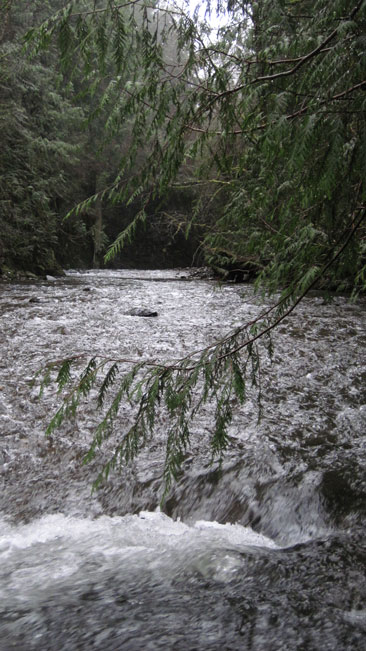
not where I caught any fish, but still pretty
I hooked my second fish in one of the more difficult spots on the river, a deep bedrock slot against a far away vertical wall with cedar branches that overhung almost to the water. The cast was right at the edge of my range but by this time I was getting pretty good at it, my spinner shooting all the way to the wall on a fast, low flightpath, landing inches from the rock. A simple retrieve would have pulled it right over the slot so I had to walk sideways as I reeled slowly in hopes that it would dip briefly low enough to attract some attention, which it did. This fish hit hard and peeled a significant portion of line off my reel. It fought a lot like a big coho, pulling and surfacing, but not leaping all that much. It also made clever attempts to wind me around several rocks and logs including one that I had to pass the pole under to keep from losing the fish. After about five minutes I slid her into the net, noting the clipped adipose fin signalling she was hatchery fish, and legal to keep. I leaned down, nearly in tears, and said "Thank you, thank you so much." before I beat it's brains in and sliced the gill rakers to bleed out downstream. I worked the entire pool once more and continued downstream. Step, cast.
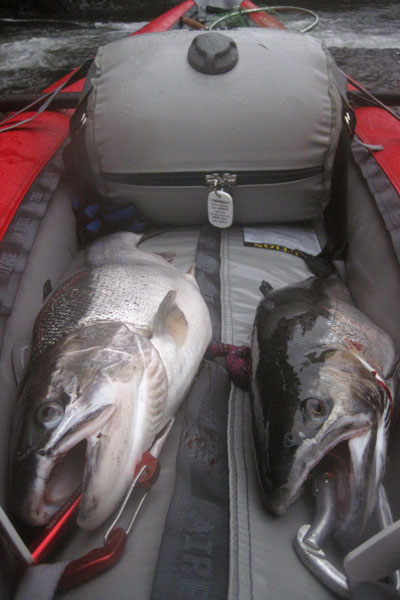
I hooked my third fish in a spot I had missed entirely or covered only briefly on previous floats. A minefield of big lure-stealing boulders lurked beneath the waters surface and there was no easy way to walk or wade the similar shoreline. This fish was smaller and quite a bit more lively, leaping and shaking, but still not the vicious adversary described in so many pornographic fishing tales. Also a clipped fish, I kept and killed him, having retained two now I legally had to quit fishing for the day. Ensconced in the trickling mossy gorges I felt a connection to the river that no amount of blazing through in a playboat could have created. I've always voiced a strong appreciation and gratitude for this river, but now I felt it in my bones, a root growing downward, anchoring me more firmly to this place I call home. I pressed my lips to a mossy trickle and drank clean clear water to wash down my peanut butter sandwich.

I returned home proud and grinning and that evening we ate some fish, froze some fish, and gave some fish away. I stayed up late, intending to wake late as well, but instead I awoke at 4am, thinking about... you guessed it, steelhead. It was like christmas morning as a little kid, I simply could not go back to sleep so I took a shower and made some coffee and slowly sorted through my fishing stuff. It was all about efficiency, the lighter and simpler my setup, the faster I could move with less hang-ups in the brush or on the kayak. Even more important was managing my own chemistry. The fish are out there but if I'm hungry, thirsty, or cold, I might blunder into a pool, might make a lazy cast, might not get quite into the slot, and might in fact miss the one fish that otherwise would have hit my line that day. I took to the tasks in my usual way, obsessively. What had previously seemed like a cold, wet, long odds gamble now felt like an exciting detective game, it went from being a drama to a tense action thriller, and that brightened my mood considerably.
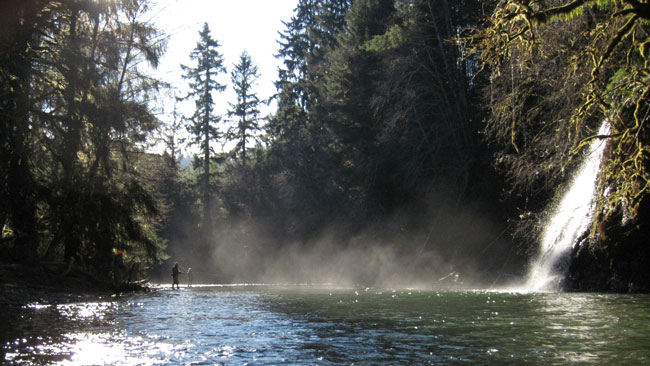
photo of the pool below the hatchery, taken midday
Beginning my float on the river this morning, as usual I left the first 1/4 mile for bank anglers as I drifted stealthily past in the twilight of dawn. I stopped at my first spot and wasn't too happy with how I covered it, though I'm not sure why, I fished it with a series of mostly clean casts, but I had a feeling that I could have spooked or missed a fish. Where before I saw miles of empty water, I now envisioned miles of hidden fish and it changed the way I did everything. I now approached a run a little more cautiously, concious of where riffles might hide my presence and where clear spot would reveal me. I casted ahead of me to check for advance scouts before wading out into enemy water. Step, cast. I was still surprised at how difficult it was to maintain this kind of focus, at how badly I wanted to stick to spots that I favored and fish them too much. This can be a decent strategy as well, and I have personally watched a fish pick up a spinner on the tenth cast to it's nose, so it's likely that I was leaving fish behind, as was evidenced by the jig and bobber guys catching fish in my wake. That was fine with me too.
I hooked my first fish at what I'm beginning to realize is a very good spot. After a few unintentionally short casts in thick overhanging branches I finally reached out through the vegetation guiding my spinner through a tiny slot in the branches to hit the pocket I wanted near the opposite bank, a cast I'd missed more often than not in the past. An average sized hatchery fish rose to the occasion with a snatch and grab and I launched into hot pursuit. It tugged and I tugged and fortunately the hooks stayed set and it was soon bleeding out on the bank. I'd learned to never walk anwhere without my net clipped to my shoulder, as annoying as that is. I finished the run and then came back to the spot for a few more casts before moving on.
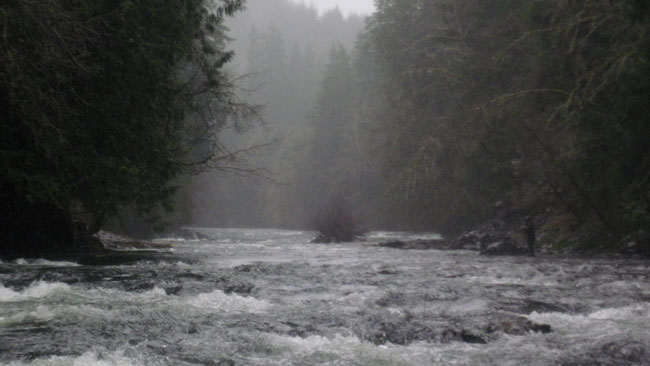
the lone fishermen
Midway through the upper section I encountered another fisherman who moved toward me, fishing upstream and wading the bank. He was a jig and bobber guy, but I recognized his movements immediately, we fished toward each other, and he asked me if I doing any good and I said a little and neither of us really looked up or back as we passed through each other. I admire these few intrepid bank anglers who seem to show up at the most unlikely locations. With sheer slippery walls that alternate sides of the river through much of the run, and one bank almost entirely private, the North Fork is not an easy place to be a 'cover ground' sort of bank fishermen. Yet these guys do make it in there and considering how many times I accidentally take a plunge in my drysuit, I'm always impressed by how dry these guys look in their neoprene waders.
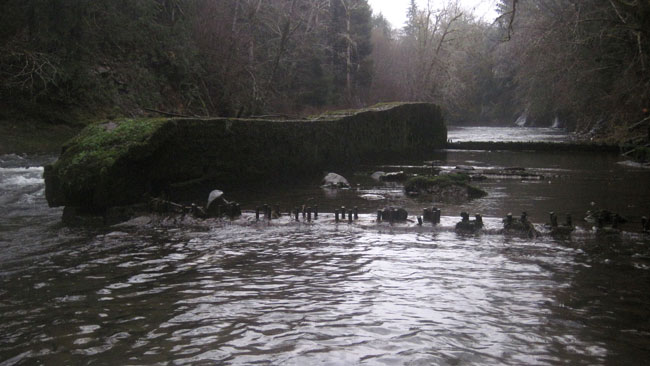
an old diversion dam, I don't know the history of this structure
The second fish hit in a spot that 'the old Brian' absolutely would have missed. A nondescript run, about two and a half feet deep with water flowing at a slow jog. I saw a bright twisting flash one second before the fish came rocketing out of the water shaking madly. I instantly knew I had a very different animal on the line than the sluggish hatchery fish I'd hooked earlier in the day. It leaped three more times, taking line the whole time, before blasting into the air a final time and spitting the offensive hook from it's jaws. The whole thing lasted about fifteen seconds and left me wide-eyed and slack-jawed wondering what the hell just happened. So that's what a wild steelhead looks like, and that was a small one. I instantly understood the fanatical passion that infects people over this fish. What an amazing creature, I'm glad to have had the chance to connect with it but I'm also glad he shook the hook. Go forth and spawn wild steelhead.
Working my way toward the first of five significant harder rapids in the river, I spotted a team of bank guys just below the drop scrambling madly to try and land a big and angry fish. It acted like the native I'd hooked the day before, but looked to be about twelve pounds. At the end of a very exciting looking fight, they carefully released it without wasting any time. I ran the drop and lost a spinner in the rock infested pools below before continuing downstream.

In the heart of three significant drops below this, I've perfected a ninja manuver whereon I leap from the kayak and onto a rock, in the middle of a class III+ rapid. If I've made this kayak fishing thing sound easy pay attention: there are significant and dangerous drops on the North Fork, and about a quarter of the pockets I fish require not only whitewater skills to reach, but precise manuvering skills to find and hold position while juggling a paddle and pole, sometimes even casting for pockets while running the rapid itself. These are rapids I've seen people swim and get hurt on, lots of bruises, broken fingers, that sort of thing. It's all marvelous fun for me, but I'd be irresponsible not to mention the risks as I am certain that someone will get a bright idea after reading this account. (please don't buy a kayak from GI-Joes and try this in waders.)
Anyways, back to my spot in the middle of the rushing rapid. I balanced and ate an orange, and carefully casted my spinner over the edge and into the jaws of totally unsuspecting steelhead. He gave it a powerful couple shakes before spitting the lure back out. I've never hooked a fish here but I've always wanted to, so even though he shook the hook, I was stoked to finally connect. Having lost two in a row I was beginning to doubt the sharpness of this spinner so I tied on another and vowed to purchase a hook sharpener. I left the pool alone for ten long minutes before trying one more time, seeing if I might pick up a buddy. No such luck. Again, it was hard to make myself move and not fish this spot to death. I slipped trying to get back onto the kayak and face planted into the rock, crushing my reel with my chest and snapping the handle off, leaving me just a small stub to reel with my thumb. You can't let a stub reel get you down though, it was going to be tricky, but on the bright side it might slow down my retrieve, which is always a good idea if you want to take a steelhead on a spinner. I kept fishing and in the next rapid my slow spinner snagged and I had to break it off. I tied on another and kept fishing.
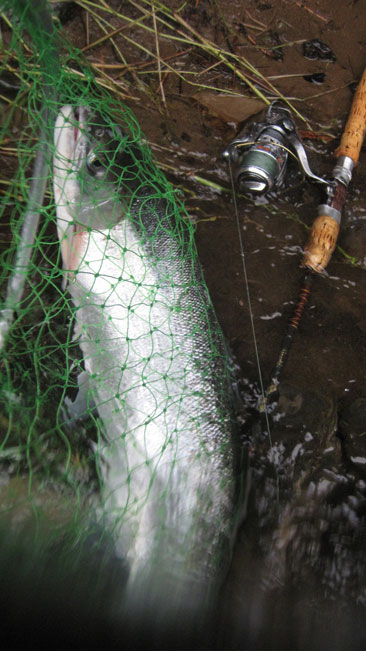
My last fish came to me on a corner that I always knew could hold a fish, but was difficult to approach unseen, and difficult to approach period. With my stub-reel I was overextending and running deep, which you can't get away with for long if you want to keep any gear, but in this case it paid off. I finally reached deep enough into the pocket to pull out that fish, whom, although a near carbon copy of my first this day, was a much more interesting adversary now that I was reeling with a stub instead of a handle. I was thrilled to net him and see that adipose fin clipped. "Thank you!" I said emphatically to my fish, to the river, to the miracle that would place me here, at this moment to catch this beautiful fish. I stunned her with a rock and tore out her gill rakers, thick red blood streaming across silvery sides. I never take for granted that I am taking a life. Even the life of a hatchery fish is a life.
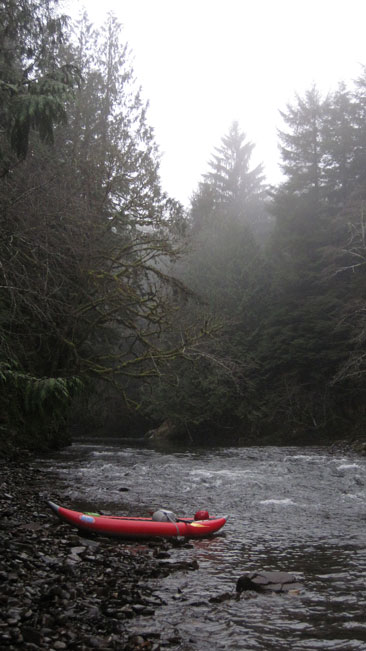
I put away the pole and drifted out of the gorge and into a dark squall with a stiff headwind. In a drysuit with many layers beneath I don't mind the rain and I drifted quietly back down to my house, enjoying the scenery and reflecting on the lessons of the last couple weeks.
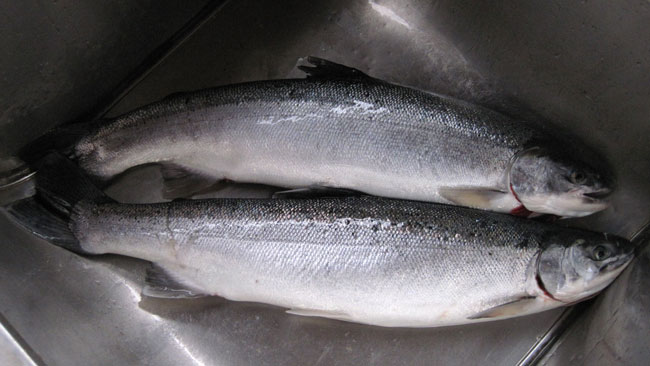
steelhead in our industrial sized steel sink, both weighed exactly 5.06 lbs

filleting on a plank is easier than a slick surface because the fish slides around less
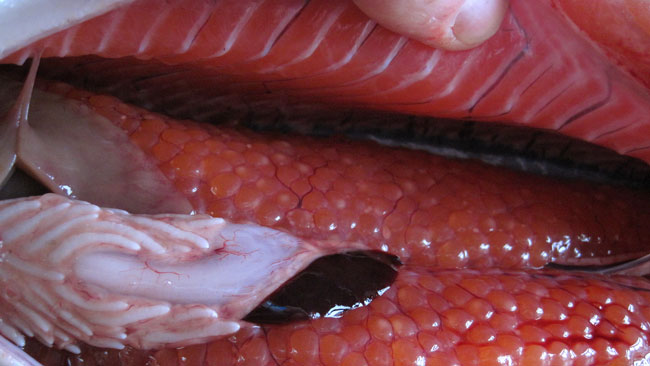
the inside of the steelhead, filled with eggs and other, um, stuff

I save the eggs. I don't personally like fishing with them, but I'm happy to salt them and give them to other fishermen.
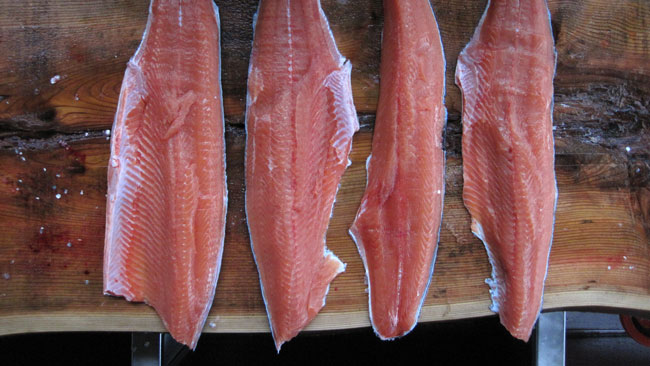
the reward
Back at the house I cracked open a beer and filleted the fish on a cedar plank that happened to be laying around from a log that I'd milled last year. A log that I found floating in the tidewater of this same river. As I slit the bellys open and rich red eggs spilled out I felt connected to the circle of life. I thought about my passion for tradtional kayaking and I pondered the wicked efficacy of man as a predator. Most of all, however, I just felt a deep gratitude for these magnificent fish. I realized that without the Hatchery we'd have to face the facts of what we've done to our wild fish runs. The way I see it, a world with too many people and too few fish is not just a physical lack, but a spiritual deprivation as well. Although there are isolated success stories, the cumulative tide is still going in the wrong direction, and every generation we lose a bit more of our soul, and the generation after than doesn't even know it's gone. There are people who try to minimize the problem, but anyone who's ever fished in Alaska or BC knows the difference. It's for this reason that I will always be a rabid environmentalist. I LOVE to fish, but I'd hang up my pole in a heartbeat if we could ever agree to collectively set our rods down for as long as it takes to recover the abundance we've lost. Maybe during that time we can talk to our own kids about what a small planet we live on, and how we all might be better off if a few generations of us had less, and not more children. It's a talk our parents should have had with us.
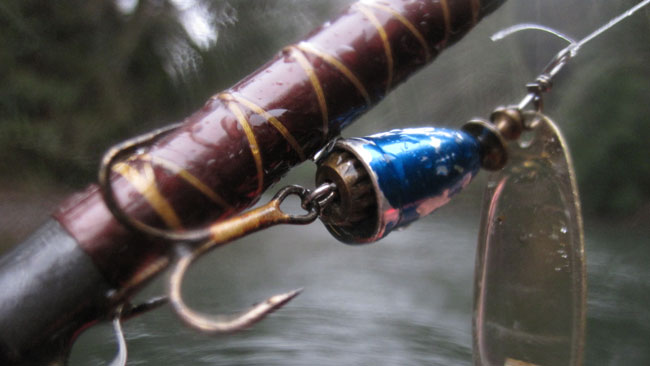
As much as I'm very relieved that this year's steelhead adventures became a success story, looking back on it I realize that it was the failures, the days of freezing cold, watching the guides, learning every slot and crack of these three miles, and finally reckoning with the tricks of my own mind, that was the real reward. Catching a steelhead is thrilling, but steelhead fishing teaches you something critical:
In a world where we can so easily change our environments as a mechanism for dealing with our problems, winter steelhead fishing teaches you to contend with the world as it is, not as we might wish it to be. It forces you to harmonize with adversity and adapt to it, and the human condition being what it is, a bit of that sort of thinking could go a long ways. Life, like steelheading, simply is what it is. You can't just throw stubborn ambition at the problem, and no amount of good intentions is going to magically put fish on your line, you need to find the flow and do what it takes, otherwise you don't catch fish. The buddhists say 'swim with the river', which is about the right attitude, but to which I'd like to add one small caveat:
don't bite anything shiny
Back to Cape Falcon Kayak